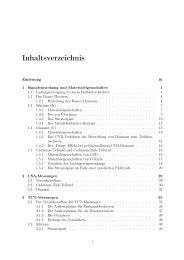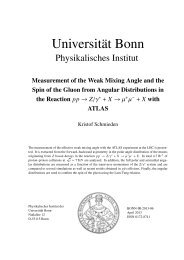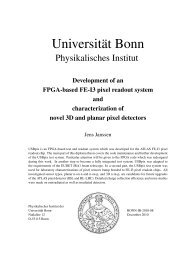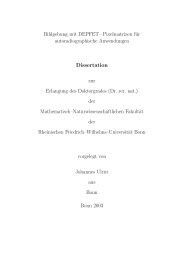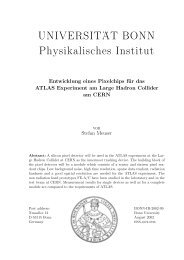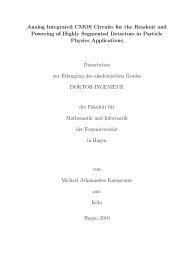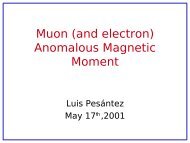UNIVERSIT . . AT BONN Physikalisches Institut - Prof. Dr. Norbert ...
UNIVERSIT . . AT BONN Physikalisches Institut - Prof. Dr. Norbert ...
UNIVERSIT . . AT BONN Physikalisches Institut - Prof. Dr. Norbert ...
Create successful ePaper yourself
Turn your PDF publications into a flip-book with our unique Google optimized e-Paper software.
3. CIX 0.2 detector<br />
3.1 Concept<br />
The simultaneously counting and integrating X-ray detector CIX was designed as a merger<br />
of two distinct signal processing concepts that are commonly used in X-ray imaging. The<br />
first concept is the photon counting or pulse mode approach. In this case detectors register<br />
individual photons by means of one or several thresholds. Depending on the number of<br />
thresholds per pixel, these devices permit tissue identification or contrast agent imaging<br />
without a variation of the X-ray beam energy. Regardless of this advantage, current ASIC 1<br />
generations only allow single pulse counting up to rates of approximately 50 Mcps/mm 2 [4]<br />
because of pulse pile-up. Therefore current counting systems are not suited for high flux<br />
applications like computed tomography where the photon rates can exceed 1 Gcps/mm 2 .<br />
In high flux conditions integrating systems are used. These detectors register the total<br />
amount of charge that is deposited inside the sensor instead of identifying individual photons.<br />
Hence, integrators can cope with very large photon fluxes but are on the other hand<br />
limited by electronic noise at low fluxes.<br />
The CIX concept combines the individual advantages of the counting and integrating concepts<br />
in every single pixel cell. By using the photon counter in the low flux regime and by<br />
relying on the integrator data under high flux conditions, CIX offers an increased dynamic<br />
range compared to counting only or integrating only systems. The second advantage of a<br />
simultaneously counting and integrating detector is the ability to reconstruct the average<br />
energy E of the registered photons. This value is obtained by dividing the signal current<br />
I, measured with the integrator, by the number of photons N registered in the counter:<br />
I · Ee/h E =<br />
N · t −1<br />
(3.1)<br />
F rame · e<br />
In this equation Ee/h denotes the electron-hole pair generation energy of the sensor material,<br />
tF rame the measurement duration and e represents the elementary charge. Medical<br />
imaging could profit from this information in terms of an improved image quality as the<br />
average photon energy gives a direct measure of the beam hardening, which, if uncorrected,<br />
leads to unwanted image artifacts. Apart from the large dynamic range and the<br />
measurement of the average photon energy, the CIX detector can also be used for dual<br />
energy imaging, i.e. the reconstruction of the photoelectric and the Compton components<br />
of the total absorption coefficient (see section 2.6). As has been demonstrated in [50], the<br />
noise correlations between the counter and the integrator measurements reduce the image<br />
noise compared to dual energy imaging devices that lack this correlation, e.g. tube energy<br />
switching or dual layer systems.<br />
3.2 CIX 0.2 ASIC specifications<br />
At the moment of writing, the CIX chip is available in its second major revision. The<br />
design of CIX 0.2 introduced a number of changes compared to the predecessor generation<br />
1 ”Application specific integrated circuit”



